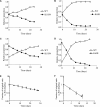The fitness cost of mutations associated with human immunodeficiency virus type 1 drug resistance is modulated by mutational interactions
- PMID: 17192300
- PMCID: PMC1865994
- DOI: 10.1128/JVI.02712-06
The fitness cost of mutations associated with human immunodeficiency virus type 1 drug resistance is modulated by mutational interactions
Abstract
It is generally accepted that the fitness cost of resistance mutations plays a role in the persistence of transmitted drug-resistant human immunodeficiency virus type 1 and that mutations that confer a high fitness cost are less able to persist in the absence of drug pressure. Here, we show that the fitness cost of reverse transcriptase (RT) mutations can vary within a 72-fold range. We also demonstrate that the fitness cost of M184V and K70R can be decreased or enhanced by other resistance mutations such as D67N and K219Q. We conclude that the persistence of transmitted RT mutants might range widely on the basis of fitness and that the modulation of fitness cost by mutational interactions will be a critical determinant of persistence.
Figures



References
-
- Barbour, J. D., F. M. Hecht, T. Wrin, T. J. Liegler, C. A. Ramstead, M. P. Busch, M. R. Segal, C. J. Petropoulos, and R. M. Grant. 2004. Persistence of primary drug resistance among recently HIV-1 infected adults. AIDS 18:1683-1689. - PubMed
-
- Brenner, B. G., J. P. Routy, M. Petrella, D. Moisi, M. Oliveira, M. Detorio, B. Spira, V. Essabag, B. Conway, R. Lalonde, R. P. Sekaly, and M. A. Wainberg. 2002. Persistence and fitness of multidrug-resistant human immunodeficiency virus type 1 acquired in primary infection. J. Virol. 76:1753-1761. - PMC - PubMed
-
- Cane, P. A. 2005. Stability of transmitted drug-resistant HIV-1 species. Curr. Opin. Infect. Dis. 18:537-542. - PubMed
-
- Delaugerre, C., L. Morand-Joubert, M. L. Chaix, O. Picard, A. G. Marcelin, V. Schneider, A. Krivine, A. Compagnucci, C. Katlama, P. M. Girard, and V. Calvez. 2004. Persistence of multidrug-resistant HIV-1 without antiretroviral treatment 2 years after sexual transmission. Antivir. Ther. 9:415-421. - PubMed
MeSH terms
Substances
Associated data
- Actions
- Actions
- Actions
- Actions
LinkOut - more resources
Full Text Sources
Medical
Molecular Biology Databases

